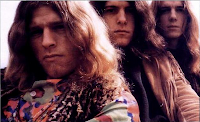So today is my daugher's birthday. Three years ago, Zoe arrived one week before Christmas, what a nice present! She is hilarious and loves music, especially the tunes from the 1960s (although this could have something do with the fact her mother usually plays the '60s station in the car!). In honor of her birthday (and while she's napping), I thought I'd post all of her favorite songs. She regularly requests these songs by name. I have no idea what drew her to this particular set of songs, but I think you'll appreciate them, too. (Since most of these tunes have been previously featured at The '60s Beat, I'll try to find different videos for each song).
Whenever Zoe thinks it's "the all-request hour" in the car, she'll first ask to hear "I Love the Flower Girl," also known as "The Rain, The Park, And Other Things" by The Cowsills. This multi-million selling single was #2 hit in 1967 for the popular family group, and it's no wonder why my kiddo loves this happy tune. This playful footage of the Cowsills family riding the miniature train looks like something my daughter would love to do.
Every time Sonny & Cher's signature song plays on the radio, my daughter excitedly shouts, "It's 'I Got You, Babe!'" Written and produced by Sonny Bono, this tune became one of her first favorites nearly a year ago; I guess the repetitive chorus stood out to her. Back in the 1965, looks like the charts would agree with Zoe, as this song reached #1 in the US and UK. This performance of the husband and wife vocal duo comes from The Beat Club, a German music program.
-----------------------------------------------------------------------------------------------------------------------
The Turtles' "Happy Together" is a newer favorite for my daughter, and she can actually sing the chorus pretty well, the descending arpeggio and all ("I can't see me..."). I discovered that she liked this song when I noticed her singing it to her stuffed animals one day. Released on Valentine's Day in 1967, this quintessential '60s song was also a #1 hit, staying at the top of the US chart for 3 weeks. Zoe refers to this one as "Happy Dugeder."
Now this next favorite of Zoe's comes as quite a surprise. With a title like "I Love You," you'd expect this Zombies' song to have a cheery tune, however, it is actually in a minor key, giving it a darker sound. Written by bassist Christ White, this British single was released in 1965 but failed to make the US chart, although it was quite popular in the Philippines. Three years later, the Californian group People! scored a big hit with their cover version of "I Love You," making them a one-hit wonder. It was so random hearing my daughter as a young 2-year-old regularly requesting to hear this one!
-------------------------------------------------------------------------------------------------------------------------
I recently let Zoe watch a few episode of The Monkees TV show and she was totally into it! Right now, her favorite Monkees' song is "Tomorrow's Gonna Be Another Day," from the group's debut, #1 hit album in 1966. Like another one of their infamous tunes, the chorus in this song includes a few "hey, hey, hey's," which has my daughter laughing every time; she actually thinks the name of this song is "Hey, Hey, Hey." Here's a typical Monkees romp from the first season of the show; Zoe loves it.
Finally, I'll end today's post with a final #1 hit, "Good Lovin'" by The Young Rascals. The backing vocals shouting "good lovin'" are what caught Zoe's attention, and she repeats the lyrics as "due lub!" Released in 1966, this high-energy tune is also great for dancing; what 3-year-old doesn't like dancing, anyway? Here's a great live performance by the blue-eyed soul group on The Ed Sullivan Show.
Happy Birthday to my baby!















































